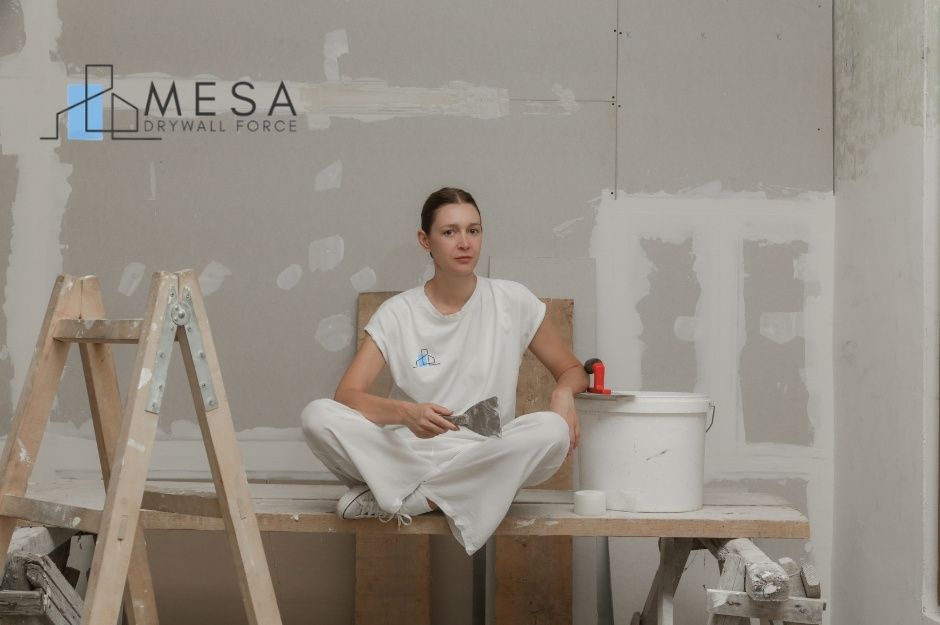Drywall Repair Laveen
High-quality Sheetrock Repair Company in Laveen, Arizona

Block walls in Laveen, Arizona face unique challenges due to the intense desert climate and shifting soil conditions. Local block wall repair contractors at Mesa Drywall Force in Laveen offer comprehensive services including crack repairs, stabilization of leaning walls, and solutions for water damage through restoration, reinforcement, and protective sealing.

Mesa Drywall Force (CP)

Located in the Sonoran Desert approximately eight miles southwest of Downtown Phoenix, Laveen's arid climate features summer temperatures averaging over 105°F, with daily highs ranging from 115°F during peak summer to 65°F in winter.
When your block wall shows signs of damage like cracks, bowing, or leaning, prompt professional repair can prevent costly structural failures and protect your property value. Serving a community that spans approximately 48 square miles with a population of 48,021 residents across ZIP codes 85339 and 85041, contractors understand the specific challenges posed by Laveen's location near the confluence of the Salt and Gila Rivers.
Your block wall's longevity depends on proper maintenance and timely repairs, especially for retaining walls that manage soil pressure and drainage. Given Laveen's two distinct wet seasons - spring rains and powerful late-summer monsoon thunderstorms - professional contractors address the unique moisture challenges that can compromise wall integrity. Professional contractors can address sloping issues, clear blocked weep holes, and implement drainage solutions to prevent future damage to your block wall structure.
Block Wall Repair Services in Laveen, Arizona
Local block wall contractors in Laveen provide specialized repair and restoration services to address structural issues, water damage, and deterioration in residential and commercial block walls. Operating in an area bounded by the Salt River to the north, South Mountain Park to the south, the Gila River Indian Community to the west, and 27th Avenue to the east, these contractors serve both the incorporated Phoenix areas (Laveen Village in Districts 7 and 8) and unincorporated Maricopa County portions of the community. Professional repair services focus on strengthening wall integrity and preventing future damage through proper reinforcement techniques.
Block Fence Restoration and Reinforcement
Block fence repair starts with a thorough structural assessment to identify weak points and damage. Contractors repair cracked mortar joints by removing damaged material and replacing it with fresh mortar.
Reinforcement often involves installing new rebar supports to strengthen the wall's foundation and structure. This process requires precise drilling and secure anchoring.
Professional contractors familiar with Laveen's agricultural heritage understand that many properties transition from historic farming and dairy operations to residential developments, requiring specialized expertise in retrofitting older block walls originally built for agricultural purposes. Professional contractors apply protective sealants to guard against moisture infiltration and weather damage. These sealants extend the life of your block wall while maintaining its appearance.
Repairing Bowing, Leaning, and Collapsing Block Walls
Signs of wall failure require immediate professional attention. Contractors use specialized equipment to measure wall displacement and assess structural integrity.
For bowing walls, repair teams install vertical steel supports and tie-backs to restore proper alignment. These reinforcements prevent further movement and stabilize the structure.
Leaning walls often need foundation repairs and soil compaction around the base, particularly important in Laveen where the area sits at 1,033 feet elevation with varying soil conditions from the historic Salt River floodplain. Contractors may need to rebuild severely damaged sections using new blocks and proper reinforcement.
Common Causes of Block Wall Damage
Water damage ranks among the most frequent issues, causing erosion and weakening mortar joints. Poor drainage near the wall base accelerates deterioration, especially during Laveen's monsoon season when powerful thunderstorms can deliver intense rainfall in short periods.
Soil pressure and improper construction can lead to structural stress, particularly in areas where Laveen's historic agricultural land with its deep wells (like the community's original deep well at Laveen School) creates varying soil density and water table conditions. Missing or inadequate rebar support often results in wall instability.
Arizona's extreme temperature fluctuations cause materials to expand and contract, creating cracks over time - a particular concern in Laveen where winter storms occasionally leave snow on the nearby Estrella Mountains while summer temperatures soar above 115°F. Settlement issues and ground movement also contribute to wall damage.
Choosing Qualified Block Wall Contractors
Look for contractors with specific experience in block wall repair and current Arizona licensing. Ask for references from recent block wall projects in Laveen, particularly those familiar with the community's ongoing development from agricultural to residential use, such as projects near the 202 Freeway extension that opened through Laveen at 59th Avenue on December 21, 2019.
Key qualifications to verify:
- Valid contractor's license
- Insurance coverage
- Experience with similar repairs
- Written warranties
- Familiarity with Maricopa County building codes and Phoenix city regulations (for Laveen Village areas)
Request detailed written estimates that outline repair methods, materials, and timeline. Compare multiple quotes but prioritize expertise over lowest price.
Retaining Wall Repair: Handling Sloping, Drainage, and Blocked Weep Holes
Proper drainage and soil stability are critical components for maintaining functional retaining walls in Laveen's desert climate. Located in the Sonoran Desert with an elevation of 1,033 feet and experiencing temperature extremes from 65°F to over 115°F, Laveen's environmental conditions create unique challenges for retaining wall maintenance. Professional repair methods focus on reinforcing structural integrity while implementing effective water management systems.
Addressing Sloping and Soil Movement
Soil movement behind your retaining wall can cause severe structural issues, particularly relevant in Laveen where the community sits near the historic confluence of the Salt and Gila Rivers, creating varied soil compositions from ancient floodplain deposits. Regular monitoring helps identify early warning signs like tilting or bulging.
Install proper rebar reinforcement to strengthen the wall against soil pressure. The rebar should extend from the footing through the entire height of the wall.
Signs of soil movement:
- Cracks in the block wall
- Gaps between blocks
- Wall leaning forward
- Soil washing out from behind the wall
- Erosion patterns common during Laveen's two wet seasons
Grade the soil properly with a slope of 1 inch per foot away from the wall, taking into consideration Laveen's relatively flat terrain and the need for proper drainage toward the Salt River or existing agricultural irrigation channels. This prevents water from pooling and reduces pressure on the structure.
Fixing Blocked or Ineffective Weep Holes
Weep holes allow water to escape from behind your retaining wall. Clean these drainage points regularly to prevent blockages, especially important in Laveen where dust storms and agricultural debris can accumulate in drainage systems. Clean these drainage points regularly to prevent blockages.
Weep hole maintenance steps:
- Remove debris and mineral deposits
- Clear openings with pressurized water
- Install mesh screens to prevent future blockages
- Add gravel backfill behind weep holes
- Check for salt buildup from Laveen's historically salty shallow well water
Space weep holes every 4 feet horizontally and vertically for optimal drainage, accounting for Laveen's seasonal monsoon patterns that can deliver intense rainfall. Replace damaged weep hole tubes during repair work.
Retaining Wall Drainage Solutions
Install a proper drainage system behind your retaining wall to prevent water accumulation, crucial in Laveen where the area's 48 square miles of largely undeveloped and agricultural property creates varying drainage patterns. French drains work effectively in Laveen's soil conditions.
Place a layer of gravel directly behind the wall. This creates a drainage zone that channels water downward to the weep holes.
Essential drainage components:
- 4-inch perforated drain pipe
- Filter fabric to prevent soil infiltration
- ¾-inch clean gravel backfill
- Proper slope for water flow
- Consideration for Laveen's two distinct wet seasons: spring rains and late-summer monsoons
Preventative Maintenance for Retaining Walls
Check your retaining wall's drainage system quarterly, with special attention before Laveen's monsoon season when powerful thunderstorms can test drainage systems. Remove any vegetation growing near weep holes or drainage areas.
Test drainage effectiveness by monitoring water flow during irrigation or rain events, particularly important in Laveen where many properties still maintain elements of the area's agricultural irrigation heritage. Look for areas where water pools or seeps through the wall face.
Maintenance checklist:
- Inspect wall alignment
- Clear drainage paths
- Check for block deterioration
- Monitor soil conditions
- Clean weep holes
- Test water flow patterns
- Remove desert vegetation that may interfere with drainage
- Monitor for effects of Laveen's extreme temperature variations
Apply waterproof sealant to block surfaces every 3-5 years to protect against moisture damage, with UV-resistant formulations essential for Laveen's intense desert sun exposure.
Best Practices for Long-Lasting Block Walls in Laveen
Block walls in Laveen face unique challenges from intense heat, monsoon rains, and shifting soil conditions specific to this Sonoran Desert community of 48,021 residents located at 1,033 feet elevation. Implementing proper construction techniques and maintenance practices will significantly extend your wall's lifespan and structural integrity.
Importance of Rebar and Reinforcement
Rebar placement forms the backbone of a sturdy block wall structure. Install vertical rebar at 32-inch intervals and horizontal rebar every third course to create a rigid grid system capable of withstanding both Laveen's summer temperatures exceeding 115°F and the soil movement common in areas transitioning from agricultural to residential use.
Your wall needs proper anchoring into a concrete foundation that extends below the frost line, though in Laveen's climate zone (Mountain Standard Time, elevation 1,033 feet), frost penetration is minimal compared to northern Arizona locations. The foundation must contain horizontal rebar tied to the vertical supports.
Use rebar ties and overlap joints properly to ensure continuous reinforcement throughout the wall. This prevents weak points where structural failures could begin.
Proper Materials for the Arizona Climate
Select concrete blocks rated for local weather extremes with adequate compression strength suitable for Laveen's temperature range of 65°F to 115°F and the area's low annual rainfall punctuated by intense monsoon events. Type S mortar provides optimal bonding in Laveen's hot, dry conditions.
Apply water-resistant sealants designed for masonry to protect against moisture damage from Laveen's two wet seasons, with UV protection essential to prevent degradation from the intense Sonoran Desert sunlight. Choose products with UV protection to prevent degradation from intense sunlight.
Your wall cap blocks need proper overlap and secure attachment to prevent water intrusion during Laveen's powerful monsoon thunderstorms that can deliver significant rainfall in short periods. Use drainage gravel behind retaining walls to reduce hydrostatic pressure.
Routine Wall Inspections and Upkeep
Check your wall every six months for new cracks, leaning sections, or signs of water damage, with special attention during Laveen's seasonal transitions when temperature changes can stress masonry materials. Pay special attention to areas near drainage points and soil grade changes.
Clean weep holes regularly to maintain proper drainage, particularly before monsoon season when Laveen experiences its most intense rainfall. Remove any vegetation growing too close to the wall structure.
Address small cracks promptly with masonry-specific patching compounds designed for extreme temperature variations like those experienced in Laveen's desert climate. Document any changes in wall alignment or new damage to track potential issues over time.
Keep irrigation systems adjusted to prevent excess water contact with the wall surface, drawing from Laveen's agricultural heritage where proper water management has been essential since the 1880s farming and dairy operations. Regular reapplication of sealants helps maintain the wall's weather resistance.
